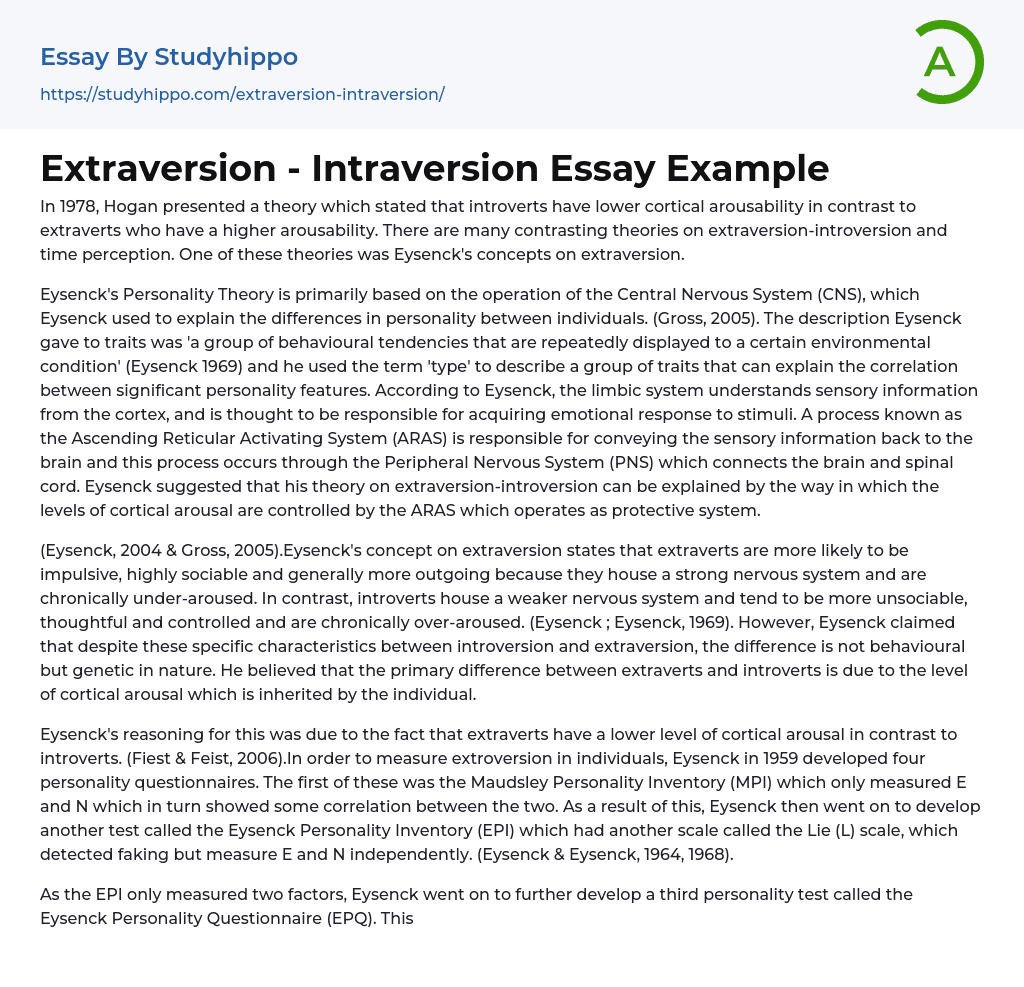In 1978, Hogan presented a theory which stated that introverts have lower cortical arousability in contrast to extraverts who have a higher arousability. There are many contrasting theories on extraversion-introversion and time perception. One of these theories was Eysenck's concepts on extraversion.
Eysenck's Personality Theory is primarily based on the operation of the Central Nervous System (CNS), which Eysenck used to explain the differences in personality between individuals. (Gross, 2005). The description Eysenck gave to traits was 'a group of behavioural tendencies that are repeatedly displayed to a certain environmental condition' (Eysenck 1969) and he used the term 'type' to describe a group of traits that can explain the correlation between significant personality features. According to Eysenck, the limbic system understands sensory information from the cortex, and is thought to be responsible for acquiring emotional response to stimu
...li. A process known as the Ascending Reticular Activating System (ARAS) is responsible for conveying the sensory information back to the brain and this process occurs through the Peripheral Nervous System (PNS) which connects the brain and spinal cord. Eysenck suggested that his theory on extraversion-introversion can be explained by the way in which the levels of cortical arousal are controlled by the ARAS which operates as protective system.
(Eysenck, 2004 & Gross, 2005).Eysenck's concept on extraversion states that extraverts are more likely to be impulsive, highly sociable and generally more outgoing because they house a strong nervous system and are chronically under-aroused. In contrast, introverts house a weaker nervous system and tend to be more unsociable, thoughtful and controlled and are chronically over-aroused. (Eysenck ; Eysenck, 1969). However, Eysenck claimed that despite these specific characteristics between introversion and
extraversion, the difference is not behavioural but genetic in nature. He believed that the primary difference between extraverts and introverts is due to the level of cortical arousal which is inherited by the individual.
Eysenck's reasoning for this was due to the fact that extraverts have a lower level of cortical arousal in contrast to introverts. (Fiest & Feist, 2006).In order to measure extroversion in individuals, Eysenck in 1959 developed four personality questionnaires. The first of these was the Maudsley Personality Inventory (MPI) which only measured E and N which in turn showed some correlation between the two. As a result of this, Eysenck then went on to develop another test called the Eysenck Personality Inventory (EPI) which had another scale called the Lie (L) scale, which detected faking but measure E and N independently. (Eysenck & Eysenck, 1964, 1968).
As the EPI only measured two factors, Eysenck went on to further develop a third personality test called the Eysenck Personality Questionnaire (EPQ). This third test included the P scale, however, the EPQ was only a revised version on the EPI and due to many criticisms of the P scale, Eysenck developed a revised version of the EPQ. (Feist & Feist, 2006 & Gross, 2005).According to Eysenck (1997), the tests should be able to predict the results of any experimental study and social behaviour. As Eysenck's theory stated, extraversion is due to low cortical arousability and therefore, introverts in contrast to extraverts should be more sensitive to a wider diversity of stimuli and learning conditions. Eysenck went onto argue that personality theories which were efficient should predict immediate and future consequences.
(Feist ; Feist ,
2006).A study conducted by D. Zakay, J. Lomranz and M. Kaziniz (1983) on extraversion-introversion and time perception, Zakay et al stated that there was a negative relationship between extraverts and time perception.
They go on to explain that the rationale for this as extraverts needing constantly high external stimulation due to their inability to work in low external stimulation. Their study was also consistent with Eysenck (1970) and Hogan's (1978) extraversion-introversion model. They went on to conclude that although results were consistent, further experimentation would be required to confirm these findings.
- Pregnancy essays
- Death essays
- Asthma essays
- Chronic Pain essays
- Diabetes essays
- Infection essays
- Infertility essays
- Pain essays
- Sexually Transmitted Disease essays
- Cholesterol essays
- Epidemic essays
- Pathogen essays
- Symptom essays
- Water supply essays
- Myocardial Infarction essays
- Chronic essays
- Hypertension essays
- Black Death essays
- Breast Cancer essays
- Down Syndrome essays
- Apoptosis essays
- Tuskegee Syphilis Experiment essays
- Type 2 Diabetes essays
- Emergence essays
- Anxiety Disorder essays
- Post-traumatic Stress Disorder essays
- Business Law essays
- Contract essays
- Consumer Protection essays
- Property essays
- Ownership essays
- Agreement essays
- Common Law essays
- Contract Law essays
- Justice essays
- Security essays
- Tort Law essays
- United States Constitution essays
- Crime essays
- Lawsuit essays
- Treaty essays
- Family Law essays
- Marijuana Legalization essays
- Constitution essays
- War on Drugs essays
- Court essays
- Jury essays
- Police essays
- Protection essays
- Community Policing essays




